

Five leaf Akebia (Akebia quinata) is a twining vine with green leaves arranged in a palmate shape. Maroon to purple flowers have the slight aroma of chocolate and bloom early in the spring. As with most vines, they are not low maintenance due to their nature and purpose in life. Vines by nature are kind of like freeloaders that want to use other things (and other plants) for free support. This does not directly parasitize the tree but can add a lot of weight (storm damage) and shade out it's foliage. It requires training to grow on some structures but will generally twine and try to grow to the highest point possible. When properly trained on a trellis or pergola, akebia can be amazing. It will grow in just about any soil and tolerate full shade to full sun. It may be used as a groundcover if nothing to climb on or an edible plant if you pollinate the flowers by hand. There are varieties available that when crossed, produce edible fruit. Akebia is invasive in some parts of the country but this is not the case in Kansas. Blooms occur in march or april very early when frosts are still occurring but with little damage to the plant. Foliage is persistent and semi evergreen until 10-15 degrees F.
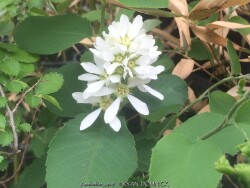

This serviceberry (Amelanchier canadensis) is a deciduous, early-flowering, large shrub or small tree which typically grows 15-25' tall with edible red to bluish-purple berry-like fruit. Native to Eastern North America. Although it is adaptable to a variety of soil and moisture conditions, it shows some drought intolerance so go with sand plums or American plums on a drier site. The delicious fruit of this and related species are eaten fresh or prepared in puddings and pies. You need to act quick before the birds strip them clean. Amelanchier canadensis is also called Shadblow Serviceberry. Great plant for the edible landscape!
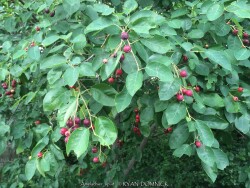

Serviceberry (Amelanchier sp.) can be a shrub or dwarf tree form with edible red to bluish-purple berry-like fruit, native to North America from Alaska across most of western Canada and in the western and north-central United States. Although it is adaptable to a variety of soil and moisture conditions, it shows some drought intolerance so go with sand plums on a drier site. The delicious fruit of this and related species are eaten fresh or prepared in puddings and pies. You need to act quick before the birds strip them clean. Great plant for the edible landscape!
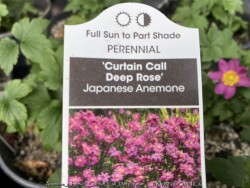

***Description for this perennial available with future update!***
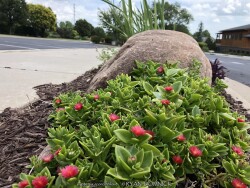

Red Apple Ice Plant (Aptenia / Mesembryanthemum cordifolia) is grown in Kansas as an annual or potted patio plant. Brilliant green glossy leaves contrast magenta flowers all summer! Plant in full sun with dry to average soil. In moist soils, this plant will grow rapidly and bloom less which may be good or bad. Flowers love the sun, but close up at night and remain closed on cloudy days. Plants will flower right up to frost and survive until a hard freeze of 23 degrees F is reached. If growing as a potted plant and trying to overwinter, watch out for scale and mealybugs. To discourage these pests, allow to go partially dormant and keep in a near freezing garage all winter. Cut back any old foliage and stems and place outside in mid-spring in full sun. These pests are never have time to establish in 1 growing season and are rarely a problem when actively growing as an annual in your landscape. Botanical name has recently changed to Mesembryanthemum cordifolium. Also known as Baby Sun Rose or Heartleaf Ice Plant. A variegated form is also available.
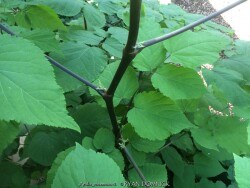

American Spikenard (Aralia racemosa) matures to 3-5' in height and has green flowers with attractive reddish purple berries in early fall. Spikenard is a true herbaceous perennial in that it dies back each fall and emerges from the ground up each spring. So large and broad, it is sometimes confused for a woodland shrub. It prefers wet to medium soil but tolerated dry-shade when mature in rich clay soils. Many woodland plants have already finished flowering when Spikenard blooms and shows off its beautiful berries. Cut the entire plant down in fall as there is no winter interest. In Kansas landscapes, use in Woodland gardens, sun dappled shade gardens, naturalized areas, wild gardens and native plant gardens. Plant as a specimen focal point or small grouping backdrop for shorter plants to contrast in the shade garden.
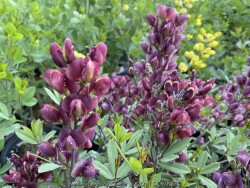

The False Indigo species (Baptisia) features beautiful compact bluish green leaves arranged in groups of three. Like many members in the legume family, they are nitrogen fixing plants which means they produce their own nitrogen in the soil through a symbiotic relationship with bacteria. The flowers bloom above the foliage normally in April and May. Common baptisia flower colors include white, purple, lavender, yellow, and pink as well as uncommon colors ranging from deep purple to maroon and even coppery orange. Considered a great North American native three season plant, the foliage always emerges very attractive followed by flowers that do not need deadheading. Foliage generally lasts pretty nice through hot summers and into fall turning black with first freeze. Seed pods also turn charcoal black when ripe and have considerable ornamental interest and useful in dried flower arrangements. At some point in the fall, it can be cut down early for a clean look or left for winter interest. Baptisia generally do well in droughty clay soils in full to part sun. There is only one pest that may create problems called the Genista Broom Moth. It may occur in Kansas when weather conditions are consistently dry and over 95 degrees F. It is treatable if you act fast but if not, it only destroys the foliage late in the season and does not kill the plant. Baptisia has several enormous spreading taproots which store water and energy and can make transplanting difficult. Plantings look good as specimen or in small groups; and it's ok even preferable if they grow together and touch other plants. That helps eliminate available sunlight and discourages weeds. It is hard to picture a native plant garden or any perennial garden without Baptisia. Considered a once "it's there, it's always there" plant. >>>>>Baptisia 'Burgundy Blast' features dark wine purple flowers are produced over very dark blue-green foliage. When it is in bloom, it is a stunning display of color. This extremely long-lived perennial could be used instead of a shrub in landscape settings, with minimal care required to thrive year after year.
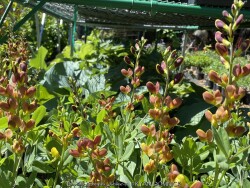

The False Indigo species (Baptisia) features beautiful compact bluish green leaves arranged in groups of three. Like many members in the legume family, they are nitrogen fixing plants which means they produce their own nitrogen in the soil through a symbiotic relationship with bacteria. The flowers bloom above the foliage normally in April and May. Common baptisia flower colors include white, purple, lavender, yellow, and pink as well as uncommon colors ranging from deep purple to maroon and even coppery orange. Considered a great North American native three season plant, the foliage always emerges very attractive followed by flowers that do not need deadheading. Foliage generally lasts pretty nice through hot summers and into fall turning black with first freeze. Seed pods also turn charcoal black when ripe and have considerable ornamental interest and useful in dried flower arrangements. At some point in the fall, it can be cut down early for a clean look or left for winter interest. Baptisia generally do well in droughty clay soils in full to part sun. There is only one pest that may create problems called the Genista Broom Moth. It may occur in Kansas when weather conditions are consistently dry and over 95 degrees F. It is treatable if you act fast but if not, it only destroys the foliage late in the season and does not kill the plant. Baptisia has several enormous spreading taproots which store water and energy and can make transplanting difficult. Plantings look good as specimen or in small groups; and it's ok even preferable if they grow together and touch other plants. That helps eliminate available sunlight and discourages weeds. It is hard to picture a native plant garden or any perennial garden without Baptisia. Considered a once "it's there, it's always there" long lived plant. >>>>>Baptisia 'Cherries Jubilee' features deep maroon buds open to bicolor maroon and yellow flowers held on strong scapes above the blue-green foliage in late spring to early summer. Secondary branching on the flower stems makes this variety especially floriferous. As the flowers age, they turn gold creating the bi-color effect! This extremely long-lived perennial could be used instead of a shrub in landscape settings, with minimal care required to thrive year after year.>>>>>This plant is a member of the DECADENCE® series from Walters Gardens, Inc.
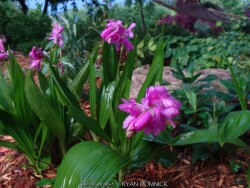

Hardy Ground Orchid (Bletilla striata) is planted for its attractive green foliage with and amazing spring flower display of pink and magenta "orchid-like" flowers. Foliage maintains well all season provided that certain cultural conditions are met. Native to Chinese forests with humusy, well-drained soil in part shade to full shade, it needs constantly moist to average soil rich in organic matter but avoid clay. If low temperatures hit -10 degrees F, it may kill an un-mulched plant; protect any zone 6 perennial with thick layer of mulch. I have occasionally seen entire plantings wiped out at -10 to15 degrees F with no mulch or snow cover. Good late summer flowering shade plant which mixes well with hostas and ferns in the shade garden. Generally this plant has declined after a few years in our Kansas display garden but worth a try in perfect soils in well-tended shade gardens.
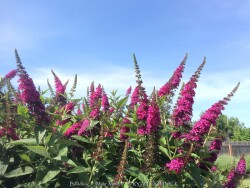

Butterfly Bush (Buddleia) are workhorses in the pollinator garden. Flower panicles come in a variety of colors mostly including shades of lavender, magenta, violet, pink, and white. Most Butterfly Bushes bloom on new wood so trimming off winter kill or complete rejuvenation will not affect flowering. In fact, flowering is often bigger and bolder from new water sprout growth when trimmed to the ground each year. Most Butterfly Bushes in zone 6 are maintained this way. Foliage is typically an attractive greenish-gray to mint green and persists into the fall until hard freezes occur. Use in the landscape in small or large groupings for its amazing flower power! Plants grow best in full sun with medium to dry soils. Drought tolerance is high with established plants so extra watering is rarely needed in our East Kansas climate with 40 inches of rain per year. Obviously, Butterfly Bush attracts lots of butterflies. There has been some debate in recent years on whether to plant Butterfly Bush because it's a non-native plant. Being a native of China, it has no pest or disease problems here. It is invasive in some parts of the country but cold Kansas winters keep it and check and without any self-seeding problems here. If you are still worried about it, there are several sterile varieties to choose from. There have been many drastically improved cultivars in the last 10 years aiming to improve cold hardiness, bloom size, eliminate seeding, and improve growth habits. Buddleia x 'Miss Molly' is a Proven Winners® plant With its intensely colored blooms and refined habit, 'Miss Molly' is the queen of the summer garden. Its fragrant flowers are the closest to red of any Butterfly Bush and appear for months every summer without deadheading. Unlike older varieties of Butterfly Bush, 'Miss Molly' reaches just 4-5' tall, so it's easy to work into any sunny landscape. This non-invasive variety thrives in hot climates. Butterflies and hummingbirds will find it as irresistible as you do! In Eastern Kansas, 'Miss Molly' has performs WELL for over 10 years with just about everything nature has to challenge it! Heat and drought are tolerated. Cold tolerance is no problem in our zone 6. If winter die-back occurs, cut back in March/April and flowers will occur on new growth in summer. No disease or pest problems. Combine with caryopteris and crapemyrtle to create a late season "all you can eat" buffet for pollinators! All Proven Winners® plants are legally propagated, healthy and vigorous, true to name, and tagged with color pictures and growing information.
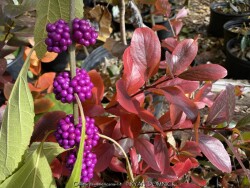

American Beautyberry (Callicarpa americana), native to Southeast US including Oklahoma and Missouri, is one of the most unique and attractive shrubs for berry production. Considered a three-season shrub, green foliage emerges in spring with attractive clusters of tiny pink flowers in summer. Big conglomerates of fruit clusters occur along the stem at evenly spaced intervals. Bright purple in color, the fruit is very effective through the month of October and November in our Zone 6a Kansas climate. Fall foliage is bright yellow often contrasting with the purple berries in November. By the following spring, winter kill to the ground will almost always occur as temperatures regularly drop to 0 degrees F or below. Cut to a few inches off the ground as you would with a perennial. You may choose to do this rejuvenation anyways in Southern areas if it has not been done in a few years to increase fruit production on vigorous new growth. New shoots create fountain-shaped shrub 3-4' after rejuvenation. Flowering occurs on new wood so you will always have berries when using this method. Purple berry clusters are highly ornamental and eaten only very slowly (never stripped clean) by birds. In southern parts of its range, full to part shade is best. However, full to part sun is recommended in zone 6 to maximize energy production needed from the sun in a shorter growing season. Mild drought is tolerated at the expense of dropping fruits if it gets too dry. Our plants in the display garden survived the winter of 2021 with temperatures reaching -16 degrees F coming up reliably from the ground each year. Overall, this is a great "woody perennial" for the Kansas landscape that is unfortunately often underused.
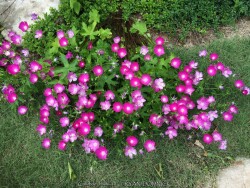

Upright Winecups (Callirhoe bushii) is also called Bush's Poppy Mallow. This plant grows from a carrot like taproot sporting a cluster of semi evergreen foliage around the base. In spring, new upright and prostrate growing vines spread in all directions along the ground up to 3 to 4 feet away from the taproot but do not root along the way. By late May or early June, magenta red "wine cup" shaped flowers cover this plant. The show last for about 4 to 6 weeks or until severe summer drought sets in. Usually in July, the flowering is complete and will set seed if allowed. Foliage will look bedraggled enough to justify complete cut back. This may be a good time to mulch unless you already mulched during the spring. When cooler weather returns in the fall, new growth emerges from the taproot looking attractive again. Secondary flowering may also occur in early fall.especially on summer planted plants. Bush's Poppy Mallow is a rare native wildflower of Missouri, Kansas, Arkansas and Oklahoma in rocky open woods and ravine bottoms. Bush's Poppy Mallow appreciates well drained soil and full to part sun. However we have found that it will still bloom and tolerate almost full shade (just a couple hours) if needed and our 40 inches of rain per year. A great plant for the top of a retaining wall, native pollinator gardens, or to even among other perennials to provide texture and contrast. It's one Achilles' heel is rabbits. Rabbits are usually only a problem in crowded suburbs where they have a little wild vegetation to eat and no predators. Gardeners with lots of established plants usually do not have rabbit problems. If rabbits are a problem for you, and you still want to grow upright wine cups, cover the plant with a bowl shaped piece of chicken wire attached with weed barrier pins. This will allow the taproot and basil foliage to get established the first year without any browsing (flowers may get eaten); after removing the cage the second year, the plants will generally outgrow any rabbit browsing. Other problems could be root rot but I have generally not seen that even in clay soils in Lawrence Kansas. Self seeding should be allowed to gently occur around the base of the plant to ensure a thick groundcover; these plants tolerate crowded conditions and will not crowd each other out or need division. This is one of the most iconic and beautiful native wildflowers!
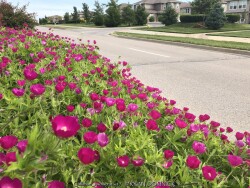

Wine cup (Callirhoe involucrata) is also called purple poppy mallow. This plant grows from a carrot like taproot sporting a cluster of semi evergreen foliage around the base. In spring, new prostrate growing vines spread in all directions along the ground up to 3 to 4 feet away from the taproot but do not root along the way. By late May or early June, magenta red "wine cup" shaped flowers cover this plant. The show last for about 4 to 6 weeks or until severe summer drought sets in. Usually in July, the flowering is complete and will set seed if allowed. Foliage will look bedraggled enough to justify complete cut back. This may be a good time to mulch unless you already mulched during the spring. When cooler weather returns in the fall, new growth emerges from the taproot looking attractive again. Secondary flowering may also occur in early fall.especially on summer planted plants. Poppy mallow winecup is a native plant of the great plains south to Texas and includes most of Kansas. As with most plants native to prairie areas, winecup appreciates well drained soil and full sun. However we have found that it will tolerate almost full shade if needed and our 40 inches of rain per year. A great plant for the top of a retaining wall, native pollinator gardens, or to even among other perennials to provide texture and contrast. It's one Achilles' heel is rabbits. Rabbits are usually only a problem in crowded suburbs where they have a little wild vegetation to eat and no predators. Gardeners with lots of established plants usually do not have rabbit problems. If rabbits are a problem for you, and you still want to grow wine cups, cover the plant with a bowl shaped piece of chicken wire attached with weed barrier pins. This will allow the taproot and basil foliage to get established the first year without any browsing; after removing the cage the second year, the plants will generally outgrow any rabbit browsing. Other problems could be root rot but I have generally not seen that even in clay soils in Lawrence Kansas. Self seeding should be allowed to gently occur around the base of the plant to ensure a thick groundcover; these plants tolerate crowded conditions and will not crowd each other out or need division. This is one of the most iconic and beautiful native wildflowers!
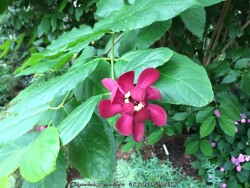

Aphrodite Sweetshrub (Calycanthus x 'Aphrodite') is covered in big, glossy, medium-green leaves. This shrub explodes with enormous cupped flowers that look a bit like a deep red magnolia. They start in early summer with a big flush of flowers continuing to bloom sporadically all summer long. This is a quite large shrub that needs plenty of space to look its best, but if you have the room for it, there are few better ways to use it! 'Aphrodite' is a hybrid between our native Calycanthus and the Asian species, x Sinocalycanthus. You're probably wondering if it's fragrant, and the answer is - it depends. The scent varies based on the age of the bloom, the time of day, and the flower itself. Some people say they smell like pineapple, others apples, others bubblegum, and some get no scent at all. Even if you never sense a whiff off this plant, its fabulous flowers are more than enough reward. Prune after flowering to maintain shape. This Calycanthus performs amazingly well in eastern Kansas landscapes. It is great along a woodland edge or in morning sun. When planted in full shade with rich soil in our Lawrence, KS Zone 6a display garden, growth is very rapid and flowers completely cover the shrub for a few weeks in early summer. Yes, you heard right, this shrub is will flower in full shade. It tolerates a wide variety of soil types including clay but needs prefers well-drained soil high in organic matter. Adaptable to mild drought and heat (plant in full shade in southern zones) but greatly improved with rich, moisture-retentive soils. Typically, our 40 inches of rainfall per year in Eastern Kansas is sufficient. Summer foliage is virtually pest-free. All Proven Winners® plants are legally propagated, healthy and vigorous, true to name, and tagged with color pictures and growing information.
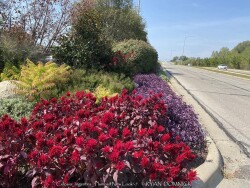

***Description for this plant available with future update!***
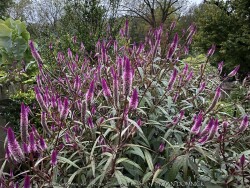

Flamingo Feather Celosia (Celosia argentea var. spicata 'Flamingo Feather') is a large magenta flowering annual. Growth starts off in May when temperatures have warmed. Beautiful dark green foliage has reddish colored back sides of the leaf and magenta stems. After achieving about 3 to 4 feet in height and wide, fuzzy magenta flower spikes begin to appear usually by July. Ultimate height can reach 5-6 feet as flowering becomes more dense and continues until frost providing an excellent long-lasting show. Celosia has little winter interests so you may cut down promptly after the first fall freeze. This is a time to save some of the seeds if you wish to sprinkle them in a new area next year. You may or may not enjoy the fact that the Celosia will easily re-seed itself in areas that you do not mulch. Seedlings come up rather late and can create a carpet under the previous years planting location. We usually allow self-seeding to occur in our display garden in select areas and then spray Roundup or mulch wherever you do not want seedlings. Flamingo Feather Celosia needs full sun for best flowering but tolerated virtually any soil conditions including compacted driveway gravel. Use Flamingo Feather Celosia where you need to fill up a lot of space in a hurry or just like lots of magenta flowers in the fall when other things are not blooming. Celosia is also grown as a food crop in Africa and Southeast Asia.
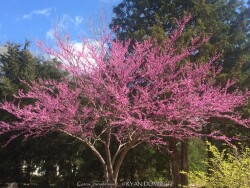

***Tree descriptions available with future update!***Eastern Redbud, is also known as Cercis canadensis
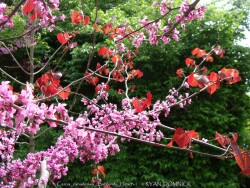

Cercis canadensis Burgundy Hearts® is an improved reddish purple-leaf variety developed by Greenleaf Nurseries in Oklahoma. Burgundy Hearts more drought and heat tolerant. Pinkish-lavender April flowers bloom for about a month before leaves appear. It has a more or less rounded form, wider than it is tall. This small deciduous tree is known for its heart-shaped leaves that hold their dark color longer in the summer, taking on reddish wine tones towards the fall. Many of the problems with the regular species redbud tree are not an issue with this improved cultivar. It is to be expected however that all Redbuds have a relatively short lifespan of 20-40 years but even so, are worth planting for its beautiful flowers. It is not weak wooded and makes a nice hot non-sparking firewood. The short life span is not due to breakage so much as it is to the tree's susceptibility to heart-rot especially when branch crotches form and get older. Other problems include canker, verticillium wilt and root rot. Most redbud varieties thrive in full sun to partial shade. They will tolerate full shade but become elongated and thin as they reach for the sun. Redbuds do well in most soil types but adequate drainage is a must; it can tolerate dry shade of Eastern Kansas forests receiving at least 35" of rainfall per year. The species is a native from southern Canada to Florida, east to Kansas. The regular species also has the potential to self seed in your yard but not Burgundy Hearts. As a dwarf tree, use 'Merlot' as a specimen or part of a group. It reaches about 20 to 30 feet high and wide in full sun. Reddish leaf color emerges in the spring and is maintained all summer long if in mostly full sun. The color of older purple redbuds (like Forest Pansy) fades to dark green as the summer heat intensifies.
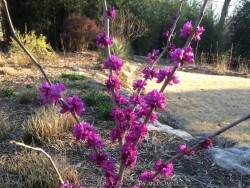

Don Egolf Redbud (Cercis canadensis 'Don Egolf') is a dwarf flowering shrub redbud native to China. It has the typical heart shaped green Redbud foliage and deep magenta flowers. The bark is more of a beige or light tan color with black buds. Flowering begins in April with flower buds starting on old wood all the way to the ground level. Flowering even occurs on very young plants only several inches tall. Because this is a Chinese species, no seed pods form like on native Redbuds. After many years, heights of 8 to 10 feet may be achieved on multi-stemmed plants. Culture conditions are pretty easy; just provide average garden soil, reasonable water, and mostly sun. In Eastern Kansas, typically our 40 inches of rainfall is sufficient without extra water if planted in good soils. Don Eagles Red has been growing in our display garden for over 10 years blooming consistently with no problems. It survived -16 degrees F and a week of single digit highs in February, 2021 with no damage to flower buds.
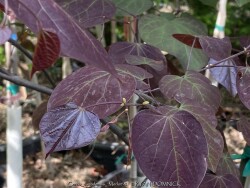

This purple-leaf Redbud (Cercis canadensis 'Merlot') is a canadensis and texensis cross to produce a more drought and heat tolerant tree. It has glossy, small rounded dark purple leaves and has an upright vase-shaped growth habit. This small deciduous tree is known for its stunning display of colorful blooms a deep magenta color. Many of the problems with the regular species redbud tree are not an issue with this improved cultivar. It is to be expected however that all Redbuds have a relatively short lifespan of 20-40 years but even so, are worth planting for its beautiful flowers. It is not weak wooded and makes a nice hot non-sparking firewood. The short life span is not due to breakage so much as it is to the tree's susceptibility to heart-rot especially when branch crotches form and get older. Other problems include canker, verticillium wilt and root rot. Most redbud varieties thrive in full sun to partial shade. They will tolerate full shade but become elongated and thin as they reach for the sun. Redbuds do well in most soil types but adequate drainage is a must; it can tolerate dry shade of Eastern Kansas forests receiving at least 35" of rainfall per year. The species is a native from southern Canada to Florida, east to Kansas. The regular species also has the potential to self seed in your yard but not 'Merlot'. As a dwarf tree, use 'Merlot' as a specimen or part of a group. It reaches about 12 to 15 feet high and wide in full sun. Reddish leaf color emerges in the spring and is maintained all summer long if in mostly full sun. The color of older purple redbuds (like Forest Pansy) fades to dark green as the summer heat intensifies.
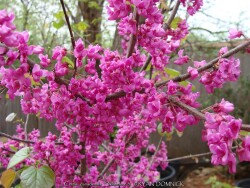

***Tree descriptions available with future update!***
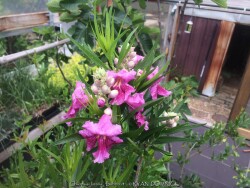

Desert Willow is a small open irregularly branched tree or large shrub with bright green narrow leaves (but not related to true willows) It features gorgeous pink, white and magenta snapdragon-like flowers with yellow throats. Blooming season is immensely long beginning in June continuing all summer until frost. Desert Willow grows in all soil types here in Kansas but prefers rich silty loam. It will not grow in excessively wet anaerobic soils though. Absolute full sun is needed for best growth to produce flowers and avoid spindlyness. In the landscape, Desert Willow can be used as a specimen shrub or small tree. It handles hot west for south locations very well. It's native range covers most of the Southwest and western Texas along streams and riparian areas. Being surprisingly cold hardy here, Several Desert Willow cultivars can be found at the Denver Botanic Gardens in Denver CO (zone 5b) and at the Dyck Arboretum in Hesston, Kansas (zone 6b). Bubba Desert Willow (Chilopsis linearis 'Bubba') has been thriving in our display garden and other Lawrence, KS locations for over 15 years and has endured temperatures as low as a -18. During the most severe winters, winter kills it down to the ground. However, just like Crapemyrtle or Butterfly Bush, Desert Willow blooms on new wood and at a young age with blooms even occurring on 3 foot tall nursery plants. Water sprout regrowth from established landscape plants is rapid with heights reaching 5-6'. These blooms are more numerous and larger than normal, especially with a handful of time-release fertilized applied in the early spring. Bubba Magenta Desert Willow (Chilopsis linearis 'Bubba') is a vigorous, fast-growing upright selection of desert willow that originated in Texas. Compared to other selections it has a strong vertical form and is less shrubby. It also has glossy, darker green, more lush foliage than other desert willows.


***Description for this hardy tropical available with future update!***>>>>>Desert Willow is a small open irregularly branched tree or large shrub with bright green narrow leaves (but not related to true willows) It features gorgeous pink, white and magenta snapdragon-like flowers with yellow throats. Blooming season is immensely long beginning in June continuing all summer until frost. Desert Willow grows in all soil types here in Kansas but prefers rich silty loam. It will not grow in excessively wet anaerobic soils though. Absolute full sun is needed for best growth to produce flowers and avoid spindlyness. In the landscape, Desert Willow can be used as a specimen shrub or small tree. It handles hot west for south locations very well. It's native range covers most of the Southwest and western Texas along streams and riparian areas. Being surprisingly cold hardy here, Several Desert Willow cultivars can be found at the Denver Botanic Gardens in Denver CO (zone 5b) and at the Dyck Arboretum in Hesston, Kansas (zone 6b). Bubba Desert Willow (Chilopsis linearis 'Bubba') has been thriving in our display garden and other Lawrence, KS locations for over 15 years and has endured temperatures as low as a -18. During the most severe winters, winter kills it down to the ground. However, just like Crapemyrtle or Butterfly Bush, Desert Willow blooms on new wood and at a young age with blooms even occurring on 3 foot tall nursery plants. Water sprout regrowth from established landscape plants is rapid with heights reaching 5-6'. These blooms are more numerous and larger than normal, especially with a handful of time-release fertilized applied in the early spring.
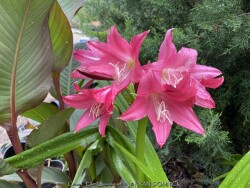

Crinums are tough, long-lived perennial bulbs with strappy leaves and fragrant, funnel-shaped flowers. In areas where the bulbs are hardy, (zones 5/6-10) these plants can reach as much as 4 feet across and bloom all summer. Crinums can live for 200-300 years in the South often found growing in cemeteries and abandoned home sites with little or no attention. The plants are native to southeast Asia often in areas with a summer monsoon and dry winter. They can also be grown as flowering summer patio plants. If growing as a potted plant and trying to overwinter, allowing the foliage to frost is ok, it will not kill the root system. However, do not allow the pot with rootball to freeze solid or go below 20 degrees for more than a few hours; move into a cold garage or basement over the winter with no watering. Cut back and allow to go dormant and place entire pot back out in April or May with a time-release fertilizer. During the growing season, fertilize, water regularly, and place in full sun. You may also plant these in the ground for an enormous tropical effect! It is easy to overwinter these in the ground in Kansas with mulch or no mulch! The trick is to plant them deep: an extra 4-6" deeper than grade or with neck of bulb completely buried. Crinums are extremely adaptable thriving in either in dry or in boggy soils. Crinums are tough, low maintenance bulbs which make them perfect for rain gardens, and although drought-tolerant, crinums bloom more if well-watered. This plant can also grow in standing water or as a potted plant in water gardens. Unlike southern climates, crinums in Kansas need full sun to grow and flower in our shorter growing season. Crinum are more cold hardy than most authorities publish; easily pushing into zone 5 for some varieties. In our trial gardens in Lawrence, KS (zone 6a), the following varieties survived after being mulched 6-12" with leaf mulch to -17 degrees F. (Crinum 'Infusion', Crinum tweedianum, Crinum 'Super Ellen', Crinum x powellii, Crinum 'White Prince') During the arctic blast of February, 2021, lows down to -17 degrees F on Feb 16th, 2021 were recorded. The longevity of this cold blast was also impressive: 10 days on a row with highs of 10-15 degrees F or lower, 8 nights of lows in the single digits and negatives, and 36 straight hours of 0 degrees F and mostly lower. No crinums were lost or harmed during this event! Crinum 'Ellen Bosanquet' has dark magenta/red flowers 24" tall


Crinums are tough, long-lived perennial bulbs with strappy leaves and fragrant, funnel-shaped flowers. In areas where the bulbs are hardy, (zones 5/6-10) these plants can reach as much as 4 feet across and bloom all summer. Crinums can live for 200-300 years in the South often found growing in cemeteries and abandoned home sites with little or no attention. The plants are native to southeast Asia often in areas with a summer monsoon and dry winter. They can also be grown as flowering summer patio plants. If growing as a potted plant and trying to overwinter, allowing the foliage to frost is ok, it will not kill the root system. However, do not allow the pot with rootball to freeze solid or go below 20 degrees for more than a few hours; move into a cold garage or basement over the winter with no watering. Cut back and allow to go dormant and place entire pot back out in April or May with a time-release fertilizer. During the growing season, fertilize, water regularly, and place in full sun. You may also plant these in the ground for an enormous tropical effect! It is easy to overwinter these in the ground in Kansas with mulch or no mulch! The trick is to plant them deep: an extra 4-6" deeper than grade or with neck of bulb completely buried. Crinums are extremely adaptable thriving in either in dry or in boggy soils. Crinums are tough, low maintenance bulbs which make them perfect for rain gardens, and although drought-tolerant, crinums bloom more if well-watered. This plant can also grow in standing water or as a potted plant in water gardens. Unlike southern climates, crinums in Kansas need full sun to grow and flower in our shorter growing season. Crinum are more cold hardy than most authorities publish; easily pushing into zone 5 for some varieties. In our trial gardens in Lawrence, KS (zone 6a), the following varieties survived after being mulched 6-12" with leaf mulch to -17 degrees F. (Crinum 'Infusion', Crinum tweedianum, Crinum 'Super Ellen', Crinum x powellii, Crinum 'White Prince') During the arctic blast of February, 2021, lows down to -17 degrees F on Feb 16th, 2021 were recorded. The longevity of this cold blast was also impressive: 10 days on a row with highs of 10-15 degrees F or lower, 8 nights of lows in the single digits and negatives, and 36 straight hours of 0 degrees F and mostly lower. No crinums were lost or harmed during this event! Crinum 'Glory' is a large crinum up to 48" tall with magenta flowers. Offsets heavily. Hardy to Zone 5b.


Crinums are tough, long-lived perennial bulbs with strappy leaves and fragrant, funnel-shaped flowers. In areas where the bulbs are hardy, (zones 5/6-10) these plants can reach as much as 4 feet across and bloom all summer. Crinums can live for 200-300 years in the South often found growing in cemeteries and abandoned home sites with little or no attention. The plants are native to southeast Asia often in areas with a summer monsoon and dry winter. They can also be grown as flowering summer patio plants. If growing as a potted plant and trying to overwinter, allowing the foliage to frost is ok, it will not kill the root system. However, do not allow the pot with rootball to freeze solid or go below 20 degrees for more than a few hours; move into a cold garage or basement over the winter with no watering. Cut back and allow to go dormant and place entire pot back out in April or May with a time-release fertilizer. During the growing season, fertilize, water regularly, and place in full sun. You may also plant these in the ground for an enormous tropical effect! It is easy to overwinter these in the ground in Kansas with mulch or no mulch! The trick is to plant them deep: an extra 4-6" deeper than grade or with neck of bulb completely buried. Crinums are extremely adaptable thriving in either in dry or in boggy soils. Crinums are tough, low maintenance bulbs which make them perfect for rain gardens, and although drought-tolerant, crinums bloom more if well-watered. This plant can also grow in standing water or as a potted plant in water gardens. Unlike southern climates, crinums in Kansas need full sun to grow and flower in our shorter growing season. Crinum are more cold hardy than most authorities publish; easily pushing into zone 5 for some varieties. In our trial gardens in Lawrence, KS (zone 6a), the following varieties survived after being mulched 6-12" with leaf mulch to -17 degrees F. (Crinum 'Infusion', Crinum tweedianum, Crinum 'Super Ellen', Crinum x powellii, Crinum 'White Prince') During the arctic blast of February, 2021, lows down to -17 degrees F on Feb 16th, 2021 were recorded. The longevity of this cold blast was also impressive: 10 days on a row with highs of 10-15 degrees F or lower, 8 nights of lows in the single digits and negatives, and 36 straight hours of 0 degrees F and mostly lower. No crinums were lost or harmed during this event! Crinum 'Infusion' is a large crinum up to 48" tall with magenta flowers. Offsets heavily. Hardy to Zone 5b.


Crinums are tough, long-lived perennial bulbs with strappy leaves and fragrant, funnel-shaped flowers. In areas where the bulbs are hardy, (zones 5/6-10) these plants can reach as much as 4 feet across and bloom all summer. Crinums can live for 200-300 years in the South often found growing in cemeteries and abandoned home sites with little or no attention. The plants are native to southeast Asia often in areas with a summer monsoon and dry winter. They can also be grown as flowering summer patio plants. If growing as a potted plant and trying to overwinter, allowing the foliage to frost is ok, it will not kill the root system. However, do not allow the pot with rootball to freeze solid or go below 20 degrees for more than a few hours; move into a cold garage or basement over the winter with no watering. Cut back and allow to go dormant and place entire pot back out in April or May with a time-release fertilizer. During the growing season, fertilize, water regularly, and place in full sun. You may also plant these in the ground for an enormous tropical effect! It is easy to overwinter these in the ground in Kansas with mulch or no mulch! The trick is to plant them deep: an extra 4-6" deeper than grade or with neck of bulb completely buried. Crinums are extremely adaptable thriving in either in dry or in boggy soils. Crinums are tough, low maintenance bulbs which make them perfect for rain gardens, and although drought-tolerant, crinums bloom more if well-watered. This plant can also grow in standing water or as a potted plant in water gardens. Unlike southern climates, crinums in Kansas need full sun to grow and flower in our shorter growing season. Crinum are more cold hardy than most authorities publish; easily pushing into zone 5 for some varieties. In our trial gardens in Lawrence, KS (zone 6a), the following varieties survived after being mulched 6-12" with leaf mulch to -17 degrees F. (Crinum 'Infusion', Crinum tweedianum, Crinum 'Super Ellen', Crinum x powellii, Crinum 'White Prince') During the arctic blast of February, 2021, lows down to -17 degrees F on Feb 16th, 2021 were recorded. The longevity of this cold blast was also impressive: 10 days on a row with highs of 10-15 degrees F or lower, 8 nights of lows in the single digits and negatives, and 36 straight hours of 0 degrees F and mostly lower. No crinums were lost or harmed during this event! Crinum 'Infusion' is a large crinum up to 48" tall with magenta flowers. Offsets heavily. Hardy to Zone 5b.


Crinums are tough, long-lived perennial bulbs with strappy leaves and fragrant, funnel-shaped flowers. In areas where the bulbs are hardy, (zones 5/6-10) these plants can reach as much as 4 feet across and bloom all summer. Crinums can live for 200-300 years in the South often found growing in cemeteries and abandoned home sites with little or no attention. The plants are native to southeast Asia often in areas with a summer monsoon and dry winter. They can also be grown as flowering summer patio plants. If growing as a potted plant and trying to overwinter, allowing the foliage to frost is ok, it will not kill the root system. However, do not allow the pot with rootball to freeze solid or go below 20 degrees for more than a few hours; move into a cold garage or basement over the winter with no watering. Cut back and allow to go dormant and place entire pot back out in April or May with a time-release fertilizer. During the growing season, fertilize, water regularly, and place in full sun. You may also plant these in the ground for an enormous tropical effect! It is easy to overwinter these in the ground in Kansas with mulch or no mulch! The trick is to plant them deep: an extra 4-6" deeper than grade or with neck of bulb completely buried. Crinums are extremely adaptable thriving in either in dry or in boggy soils. Crinums are tough, low maintenance bulbs which make them perfect for rain gardens, and although drought-tolerant, crinums bloom more if well-watered. This plant can also grow in standing water or as a potted plant in water gardens. Unlike southern climates, crinums in Kansas need full sun to grow and flower in our shorter growing season. Crinum are more cold hardy than most authorities publish; easily pushing into zone 5 for some varieties. In our trial gardens in Lawrence, KS (zone 6a), the following varieties survived after being mulched 6-12" with leaf mulch to -17 degrees F. (Crinum 'Infusion', Crinum tweedianum, Crinum 'Super Ellen', Crinum x powellii, Crinum 'White Prince') During the arctic blast of February, 2021, lows down to -17 degrees F on Feb 16th, 2021 were recorded. The longevity of this cold blast was also impressive: 10 days on a row with highs of 10-15 degrees F or lower, 8 nights of lows in the single digits and negatives, and 36 straight hours of 0 degrees F and mostly lower. No crinums were lost or harmed during this event! Crinum 'Infusion' is a large crinum up to 48" tall with magenta flowers. Offsets heavily. Hardy to Zone 5b.
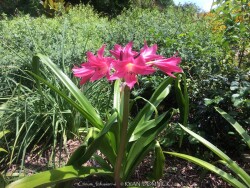

Crinums are tough, long-lived perennial bulbs with strappy leaves and fragrant, funnel-shaped flowers. In areas where the bulbs are hardy, (zones 5/6-10) these plants can reach as much as 4 feet across and bloom all summer. Crinums can live for 200-300 years in the South often found growing in cemeteries and abandoned home sites with little or no attention. The plants are native to southeast Asia often in areas with a summer monsoon and dry winter. They can also be grown as flowering summer patio plants. If growing as a potted plant and trying to overwinter, allowing the foliage to frost is ok, it will not kill the root system. However, do not allow the pot with rootball to freeze solid or go below 20 degrees for more than a few hours; move into a cold garage or basement over the winter with no watering. Cut back and allow to go dormant and place entire pot back out in April or May with a time-release fertilizer. During the growing season, fertilize, water regularly, and place in full sun. You may also plant these in the ground for an enormous tropical effect! It is easy to overwinter these in the ground in Kansas with mulch or no mulch! The trick is to plant them deep: an extra 4-6" deeper than grade or with neck of bulb completely buried. Crinums are extremely adaptable thriving in either in dry or in boggy soils. Crinums are tough, low maintenance bulbs which make them perfect for rain gardens, and although drought-tolerant, crinums bloom more if well-watered. This plant can also grow in standing water or as a potted plant in water gardens. Unlike southern climates, crinums in Kansas need full sun to grow and flower in our shorter growing season. Crinum are more cold hardy than most authorities publish; easily pushing into zone 5 for some varieties. In our trial gardens in Lawrence, KS (zone 6a), the following varieties survived after being mulched 6-12" with leaf mulch to -17 degrees F. (Crinum 'Infusion', Crinum tweedianum, Crinum 'Super Ellen', Crinum x powellii, Crinum 'White Prince') During the arctic blast of February, 2021, lows down to -17 degrees F on Feb 16th, 2021 were recorded. The longevity of this cold blast was also impressive: 10 days on a row with highs of 10-15 degrees F or lower, 8 nights of lows in the single digits and negatives, and 36 straight hours of 0 degrees F and mostly lower. No crinums were lost or harmed during this event! Crinum 'Infusion' is a large crinum up to 48" tall with magenta flowers. Offsets heavily. Hardy to Zone 5b.
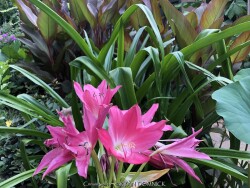

Crinums are tough, long-lived perennial bulbs with strappy leaves and fragrant, funnel-shaped flowers. In areas where the bulbs are hardy, (zones 5/6-10) these plants can reach as much as 4 feet across and bloom all summer. Crinums can live for 200-300 years in the South often found growing in cemeteries and abandoned home sites with little or no attention. The plants are native to southeast Asia often in areas with a summer monsoon and dry winter. They can also be grown as flowering summer patio plants. If growing as a potted plant and trying to overwinter, allowing the foliage to frost is ok, it will not kill the root system. However, do not allow the pot with rootball to freeze solid or go below 20 degrees for more than a few hours; move into a cold garage or basement over the winter with no watering. Cut back and allow to go dormant and place entire pot back out in April or May with a time-release fertilizer. During the growing season, fertilize, water regularly, and place in full sun. You may also plant these in the ground for an enormous tropical effect! It is easy to overwinter these in the ground in Kansas with mulch or no mulch! The trick is to plant them deep: an extra 4-6" deeper than grade or with neck of bulb completely buried. Crinums are extremely adaptable thriving in either in dry or in boggy soils. Crinums are tough, low maintenance bulbs which make them perfect for rain gardens, and although drought-tolerant, crinums bloom more if well-watered. This plant can also grow in standing water or as a potted plant in water gardens. Unlike southern climates, crinums in Kansas need full sun to grow and flower in our shorter growing season. Crinum are more cold hardy than most authorities publish; easily pushing into zone 5 for some varieties. In our trial gardens in Lawrence, KS (zone 6a), the following varieties survived after being mulched 6-12" with leaf mulch to -17 degrees F. (Crinum 'Infusion', Crinum tweeedianum, Crinum 'Super Ellen', Crinum x powellii, Crinum 'White Prince') During the arctic blast of February, 2021, lows down to -17 degrees F on Feb 16th, 2021 were recorded. The longevity of this cold blast was also impressive: 10 days on a row with highs of 10-15 degrees F or lower, 8 nights of lows in the single digits and negatives, and 36 straight hours of 0 degrees F and mostly lower. No crinums were lost or harmed during this event! Crinum 'Super Ellen' is a massive crinum (cross of Crinum 'Ellen Bosanquet' x Crinum bulbispermum) up to 60" tall with magenta flowers. Offsets heavily.
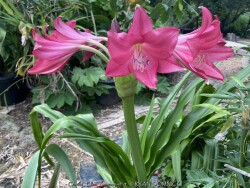

Crinums are tough, long-lived perennial bulbs with strappy leaves and fragrant, funnel-shaped flowers. In areas where the bulbs are hardy, (zones 5/6-10) these plants can reach as much as 4 feet across and bloom all summer. Crinums can live for 200-300 years in the South often found growing in cemeteries and abandoned home sites with little or no attention. The plants are native to southeast Asia often in areas with a summer monsoon and dry winter. They can also be grown as flowering summer patio plants. If growing as a potted plant and trying to overwinter, allowing the foliage to frost is ok, it will not kill the root system. However, do not allow the pot with rootball to freeze solid or go below 20 degrees for more than a few hours; move into a cold garage or basement over the winter with no watering. Cut back and allow to go dormant and place entire pot back out in April or May with a time-release fertilizer. During the growing season, fertilize, water regularly, and place in full sun. You may also plant these in the ground for an enormous tropical effect! It is easy to overwinter these in the ground in Kansas with mulch or no mulch! The trick is to plant them deep: an extra 4-6" deeper than grade or with neck of bulb completely buried. Crinums are extremely adaptable thriving in either in dry or in boggy soils. Crinums are tough, low maintenance bulbs which make them perfect for rain gardens, and although drought-tolerant, crinums bloom more if well-watered. This plant can also grow in standing water or as a potted plant in water gardens. Unlike southern climates, crinums in Kansas need full sun to grow and flower in our shorter growing season. Crinum are more cold hardy than most authorities publish; easily pushing into zone 5 for some varieties. In our trial gardens in Lawrence, KS (zone 6a), the following varieties survived after being mulched 6-12" with leaf mulch to -17 degrees F. (Crinum 'Infusion', Crinum tweedianum, Crinum 'Super Ellen', Crinum x powellii, Crinum 'White Prince') During the arctic blast of February, 2021, lows down to -17 degrees F on Feb 16th, 2021 were recorded. The longevity of this cold blast was also impressive: 10 days on a row with highs of 10-15 degrees F or lower, 8 nights of lows in the single digits and negatives, and 36 straight hours of 0 degrees F and mostly lower. No crinums were lost or harmed during this event!
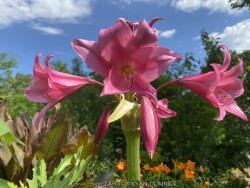

Crinums are tough, long-lived perennial bulbs with strappy leaves and fragrant, funnel-shaped flowers. In areas where the bulbs are hardy, (zones 5/6-10) these plants can reach as much as 4 feet across and bloom all summer. Crinums can live for 200-300 years in the South often found growing in cemeteries and abandoned home sites with little or no attention. The plants are native to southeast Asia often in areas with a summer monsoon and dry winter. They can also be grown as flowering summer patio plants. If growing as a potted plant and trying to overwinter, allowing the foliage to frost is ok, it will not kill the root system. However, do not allow the pot with rootball to freeze solid or go below 20 degrees for more than a few hours; move into a cold garage or basement over the winter with no watering. Cut back and allow to go dormant and place entire pot back out in April or May with a time-release fertilizer. During the growing season, fertilize, water regularly, and place in full sun. You may also plant these in the ground for an enormous tropical effect! It is easy to overwinter these in the ground in Kansas with mulch or no mulch! The trick is to plant them deep: an extra 4-6" deeper than grade or with neck of bulb completely buried. Crinums are extremely adaptable thriving in either in dry or in boggy soils. Crinums are tough, low maintenance bulbs which make them perfect for rain gardens, and although drought-tolerant, crinums bloom more if well-watered. This plant can also grow in standing water or as a potted plant in water gardens. Unlike southern climates, crinums in Kansas need full sun to grow and flower in our shorter growing season. Crinum are more cold hardy than most authorities publish; easily pushing into zone 5 for some varieties. In our trial gardens in Lawrence, KS (zone 6a), the following varieties survived after being mulched 6-12" with leaf mulch to -17 degrees F. (Crinum 'Infusion', Crinum tweedianum, Crinum 'Super Ellen', Crinum x powellii, Crinum 'White Prince') During the arctic blast of February, 2021, lows down to -17 degrees F on Feb 16th, 2021 were recorded. The longevity of this cold blast was also impressive: 10 days on a row with highs of 10-15 degrees F or lower, 8 nights of lows in the single digits and negatives, and 36 straight hours of 0 degrees F and mostly lower. No crinums were lost or harmed during this event!


This hardy Tree / Cane Cholla variety came to us from Yucca Pointe Nursery in Stillwater, OK where it grows outside in the owner Nathan Priest's display garden. This upright Cholla Cactus (Cylindropuntia imbricata) features magenta flowers and upright growth form are a unique addition to the garden. Native to arid clay soils in Western Kansas, Colorado, Oklahoma and parts of the southwestern United States and Mexico, the plant grows into a vicious unforgiving shrub if you get too close. From a distance however, this cactus has a place as one of the few upright cacti that can handle extreme cold. In fact, I have seen this species growing a few times in Lawrence, KS in desert gardens and even in full (dry) shade! Flowering in shade is doubtful though. With well drained soils and proper siting, this cactus can handle our excess rainfall in Eastern Kansas. We are testing this outside in our crevice garden among other hardy cacti and succulents! We will keep you posted. (2024)


This hardy Klein's Cholla came to us from Oklahoma nursery near Tulsa. This upright Cholla Cactus Cylindropuntia kleiniae) features pink/magenta flowers and upright growth form are a unique addition to the garden. Native to arid clay soils in New Mexico and parts of the southwestern United States and Mexico (even possibly Oklahoma), the plant grows into a vicious unforgiving shrub if you get too close. From a distance however, this cactus has a place as one of the few upright cacti that can handle extreme cold when kept dry. With very well drained soils and proper siting, this cactus seems to take our excess rainfall in Eastern Kansas. We are testing this outside in our crevice garden among other hardy cacti and succulents! We will keep you posted. (2024)


This hardy Cane Cholla came to us from Yucca Pointe Nursery in Stillwater, OK where it grows outside in the owner Nathan Priest's display garden. This upright Cholla Cactus (Cylindropuntia spinosior) features magenta flowers and upright growth form are a unique addition to the garden. Native to arid clay soils in Western Arizona and New Mexico and parts of the southwestern United States and Mexico, the plant grows into a vicious unforgiving shrub if you get too close. From a distance however, this cactus has a place as one of the few upright cacti that can handle extreme cold when kept dry. With very well drained soils and proper siting, this cactus seems to take our excess rainfall in Eastern Kansas. We are testing this outside in our crevice garden among other hardy cacti and succulents! We will keep you posted. (2024)
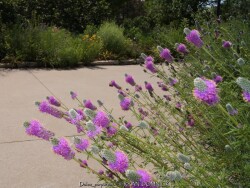

***Description for this perennial available with future update!***Great Plains Magenta Bush Clover, is also known as Dalea purpurea
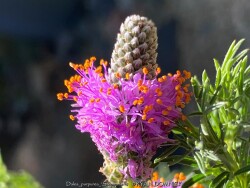

***Description for this perennial available with future update!***Great Plains Magenta Bush Clover, is also known as Dalea purpurea 'Stephanie'
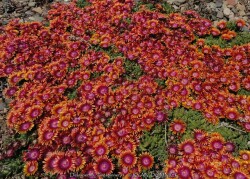

Fire Spinner Ice Plant (Delosperma 'Fire Spinner') has vibrant tri-colored flowers of orange, red and lavender that are one-of-a-kind. In Kansas, it is usually grown as an annual with outstanding color. Although very cold hardy, it cannot tolerate the combination of cold wet winters and occasionally dies even in summer from fungal diseases during hot humid weather. It could be an an evergreen groundcover under a South or West facing roof overhang against a house. Fire Spinner ice plant is sometimes grown as a hanging basket.


Fire Spinner Ice Plant (Delosperma 'Fire Spinner') has vibrant tri-colored flowers of orange, red and lavender that are one-of-a-kind. In Kansas, it is usually grown as an annual with outstanding color. Although very cold hardy, it cannot tolerate the combination of cold wet winters and occasionally dies even in summer from fungal diseases during hot humid weather. It could be an an evergreen groundcover under a South or West facing roof overhang against a house. Fire Spinner ice plant is sometimes grown as a hanging basket.
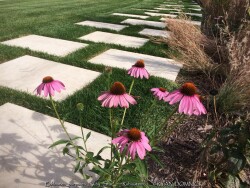

***Description for this perennial available with future update!***>>>>>Echinacea purpurea is an herbaceous perennial native to parts of eastern and midwestern United States most common in Missouri and Arkansas. Its habitats include dry open woods, prairies and barrens. Echinacea are native to North America, featuring sunflower-like flowers with a dark center and colorful petals. Colors on native plants include purple, magenta, white, yellow. Intensive breeding efforts to fish out recessive genes have brought bright orange and red into the picture. Flowers occur in early to mid summer often continuing into fall especially if dead-headed. Its individual flowers (florets) within the flower head are two-toned, having both male and female organs in each flower. (hermaphroditic) Bees and butterflies including the monarch are common pollinators. The dead flowers are attractive to some for winter interest but for those wanting a tidy your garden, they can be trimmed early. Leaving some dried seed heads will be beneficial for wildlife and provide winter food for finches and other birds. Best growth generally occurs in full to part sun with well drained soils with low to average moisture. In Eastern Kansas, typically our 40 inches of rainfall is sufficient without extra water. Coneflower can also handle short one to two day flooding events and are sometimes used along the higher perimeter of rain gardens to bring in pollinators. Coneflower mixes well with many other types of plants ranging from other native plants to evergreens to hardy tropicals. Rabbits can be a problem young immature plants. A popular method of control is covering the plant with an upside down bowl-shaped chicken wire cage for the first year to allow basil foliage to establish well. You can quickly make these yourself with a low cost roll of chicken wire. Mature plants especially in groups with other mature landscaping generally do not have rabbit problems. Flowers are also popular in the florist industry as cut flowers or in the cottage garden. The genus echinacea has undergone intense breeding with the introduction of hundreds of new cultivars in the last 10 years. Sunset Coneflower / Red-Orange Coneflower (Echinacea x Sunset) features red-orange and pinkish flowers. Most orange or red types if allowed to self-seed will produce purple flowering plants.


This beautiful small barrel type cactus (Echinocactus texensis) features stout spines, bluish green skin, and pink/magenta flowers with red throats and bright red fruits. Being indigenous to Texas, New Mexico and even parts of Oklahoma, it can handle more extreme cold and moisture than most other cacti. Called the "Horse Crippler Cactus" for obvious reasons, you wouldn't want to step on this. With extremely well drained soils and proper siting, this cactus seems to take our excess rainfall in Eastern Kansas. These and other hardy barrel cacti are perfect for a dry mounded xeriscape gardens under south facing roof overhangs where it gets no winter moisture. We are also testing this outside in our Lawrence, KS (zone 6a) crevice garden among other cold-hardy cacti, succulents, and yucca! Survival was successful during the more mild 2022-2023 winter with lows down to -5F, along with the harsh week of 2024 January weather that dipped down to -11F with a daytime high of -1F on one of those days. We will keep you posted after 2024)


***Description for this plant available with future update!*** With extremely well drained soils and proper siting, this cactus seems to take our excess rainfall in Eastern Kansas. These and other hardy barrel cacti are perfect for a dry mounded xeriscape gardens under south facing roof overhangs where it gets no winter moisture. We are also testing this outside in our Lawrence, KS (zone 6a) crevice garden among other cold-hardy cacti, succulents, and yucca! Watch for future updates-Jan-2025


***Description for this plant available with future update!*** With extremely well drained soils and proper siting, this cactus seems to take our excess rainfall in Eastern Kansas. These and other hardy barrel cacti are perfect for a dry mounded xeriscape gardens under south facing roof overhangs where it gets no winter moisture. We are also testing this outside in our Lawrence, KS (zone 6a) crevice garden among other cold-hardy cacti, succulents, and yucca! Watch for future updates-Jan-2025


The common fig (Ficus carica) is native to an area extending from Asiatic Turkey to northern India. In Kansas, plant in a protected area near the house on south or west side but will survive in other locations in full hot sun. As an edible, ornamental plant, figs are an attractive bush-like plant with sandpapery green sometimes deeply lobed leaves. There is a slight and pleasant aroma when brushing against the foliage. Fruits are dark purple to maroon. Figs love full hot sun and are very drought tolerant but will produce more fruit if watered during the summer. Expect fig tree to die to the ground each year and start growing in May a bit later than other plants. Regrowth is rapid and established figs will have dozens of 5-6' water sprouts loaded with a few hundred fruits by September. You will always get a late summer/fall crop because fruit can come from new wood. If growing as a potted patio plant, grow in full sun with plenty of water during the summer. Then in late fall before temperatures get below 20 degrees F, move into a cold garage or basement over the winter with minimal watering. Do not allow the pot with rootball to freeze solid or go below 15 degrees for more than a few hours. By March or April, the fig will be trying to grow and you may put back outside (protect from late frosts) and you will also have a spring fruit crop. Eat fresh, freeze for fruit smoothies, or dry in sun or food dehydrator. In our trial gardens in Lawrence, KS (zone 6a), several established specimens planted 5-10 years ago and mulched 1-3" with wood mulch survived -17 degrees F. During the arctic blast of February, 2021, lows down to -17 degrees F on Feb 16th, 2021 were recorded. The longevity of this cold blast was also impressive: 10 days on a row with highs of 10-15 degrees F or lower, 8 nights of lows in the single digits and negatives, and 36 straight hours of 0 degrees F and mostly lower. 'Chicago Hardy' is considered to be one of the hardiest edible figs producing reliable fruits. It's stems are hardy to 10°F and the roots are hardy to -20°F. Sometimes if prolonged September cold-fronts occur and temperatures are too low at night, green fruits will disappointingly stop ripening. Look for a hot planting location microclimate such as a West or South wall to encourage fruit to ripen. Ripening does not continue to progress if harvested early (when fruit has any green coloring present).
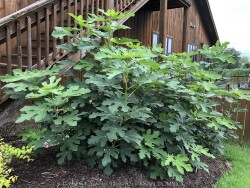

The common fig (Ficus carica) is native to an area extending from Asiatic Turkey to northern India. In Kansas, plant in a protected area near the house on south or west side but will survive in other locations in full hot sun. As an edible, ornamental plant, figs are an attractive bush-like plant with sandpapery green sometimes deeply lobed leaves. There is a slight and pleasant aroma when brushing against the foliage. Fruits are dark purple to maroon. Figs love full hot sun and are very drought tolerant but will produce more fruit if watered during the summer. Expect fig tree to die to the ground each year and start growing in May a bit later than other plants. Regrowth is rapid and established figs will have dozens of 5-6' water sprouts loaded with a few hundred fruits by September. You will always get a late summer/fall crop because fruit can come from new wood. If growing as a potted patio plant, grow in full sun with plenty of water during the summer. Then in late fall before temperatures get below 20 degrees F, move into a cold garage or basement over the winter with minimal watering. Do not allow the pot with rootball to freeze solid or go below 15 degrees for more than a few hours. By March or April, the fig will be trying to grow and you may put back outside (protect from late frosts) and you will also have a spring fruit crop. Eat fresh, freeze for fruit smoothies, or dry in sun or food dehydrator. In our trial gardens in Lawrence, KS (zone 6a), several established specimens planted 5-10 years ago and mulched 1-3" with wood mulch survived -17 degrees F. During the arctic blast of February, 2021, lows down to -17 degrees F on Feb 16th, 2021 were recorded. The longevity of this cold blast was also impressive: 10 days on a row with highs of 10-15 degrees F or lower, 8 nights of lows in the single digits and negatives, and 36 straight hours of 0 degrees F and mostly lower. 'Chicago Hardy' is considered to be one of the hardiest edible figs producing reliable fruits. It's stems are hardy to 10°F and the roots are hardy to -20°F. Sometimes if prolonged September cold-fronts occur and temperatures are too low at night, green fruits will disappointingly stop ripening. Look for a hot planting location microclimate such as a West or South wall to encourage fruit to ripen. Ripening does not continue to progress if harvested early (when fruit has any green coloring present).
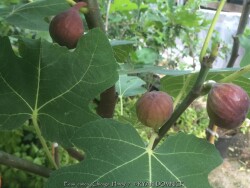

The common fig (Ficus carica) is native to an area extending from Asiatic Turkey to northern India. In Kansas, plant in a protected area near the house on south or west side but will survive in other locations in full hot sun. As an edible, ornamental plant, figs are an attractive bush-like plant with sandpapery green sometimes deeply lobed leaves. There is a slight and pleasant aroma when brushing against the foliage. Fruits are dark purple to maroon. Figs love full hot sun and are very drought tolerant but will produce more fruit if watered during the summer. Expect fig tree to die to the ground each year and start growing in May a bit later than other plants. Regrowth is rapid and established figs will have dozens of 5-6' water sprouts loaded with a few hundred fruits by September. You will always get a late summer/fall crop because fruit can come from new wood. If growing as a potted patio plant, grow in full sun with plenty of water during the summer. Then in late fall before temperatures get below 20 degrees F, move into a cold garage or basement over the winter with minimal watering. Do not allow the pot with rootball to freeze solid or go below 15 degrees for more than a few hours. By March or April, the fig will be trying to grow and you may put back outside (protect from late frosts) and you will also have a spring fruit crop. Eat fresh, freeze for fruit smoothies, or dry in sun or food dehydrator. In our trial gardens in Lawrence, KS (zone 6a), several established specimens planted 5-10 years ago and mulched 1-3" with wood mulch survived -17 degrees F. During the arctic blast of February, 2021, lows down to -17 degrees F on Feb 16th, 2021 were recorded. The longevity of this cold blast was also impressive: 10 days on a row with highs of 10-15 degrees F or lower, 8 nights of lows in the single digits and negatives, and 36 straight hours of 0 degrees F and mostly lower. 'Chicago Hardy' is considered to be one of the hardiest edible figs producing reliable fruits. It's stems are hardy to 10°F and the roots are hardy to -20°F. Sometimes if prolonged September cold-fronts occur and temperatures are too low at night, green fruits will disappointingly stop ripening. Look for a hot planting location microclimate such as a West or South wall to encourage fruit to ripen. Ripening does not continue to progress if harvested early (when fruit has any green coloring present).


The common fig (Ficus carica) is native to an area extending from Asiatic Turkey to northern India. In Kansas, plant in a protected area near the house on south or west side but will survive in other locations in full hot sun. As an edible, ornamental plant, figs are an attractive bush-like plant with sandpapery green sometimes deeply lobed leaves. There is a slight and pleasant aroma when brushing against the foliage. Fruits are dark purple to maroon. Figs love full hot sun and are very drought tolerant but will produce more fruit if watered during the summer. Expect fig tree to die to the ground each year and start growing in May a bit later than other plants. Regrowth is rapid and established figs will have dozens of 5-6' water sprouts loaded with a few hundred fruits by September. You will always get a late summer/fall crop because fruit can come from new wood. If growing as a potted patio plant, grow in full sun with plenty of water during the summer. Then in late fall before temperatures get below 20 degrees F, move into a cold garage or basement over the winter with minimal watering. Do not allow the pot with rootball to freeze solid or go below 15 degrees for more than a few hours. By March or April, the fig will be trying to grow and you may put back outside (protect from late frosts) and you will also have a spring fruit crop. Eat fresh, freeze for fruit smoothies, or dry in sun or food dehydrator. In our trial gardens in Lawrence, KS (zone 6a), several established specimens planted 5-10 years ago and mulched 1-3" with wood mulch survived -17 degrees F. During the arctic blast of February, 2021, lows down to -17 degrees F on Feb 16th, 2021 were recorded. The longevity of this cold blast was also impressive: 10 days on a row with highs of 10-15 degrees F or lower, 8 nights of lows in the single digits and negatives, and 36 straight hours of 0 degrees F and mostly lower. 'Chicago Hardy' is considered to be one of the hardiest edible figs producing reliable fruits. It's stems are hardy to 10°F and the roots are hardy to -20°F. Sometimes if prolonged September cold-fronts occur and temperatures are too low at night, green fruits will disappointingly stop ripening. Look for a hot planting location microclimate such as a West or South wall to encourage fruit to ripen. Ripening does not continue to progress if harvested early (when fruit has any green coloring present).
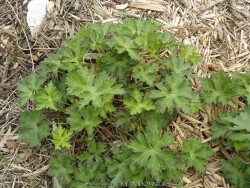

***Description for this perennial available with future update!***


***Description for this plant available with future update!*** With extremely well drained soils and proper siting, this cactus seems to take our excess rainfall in Eastern Kansas. These and other hardy barrel cacti are perfect for a dry mounded xeriscape gardens under south facing roof overhangs where it gets no winter moisture. We are also testing this outside in our Lawrence, KS (zone 6a) crevice garden among other cold-hardy cacti, succulents, and yucca! Watch for future updates-Jan-2025


Hardy Hibiscus are US native plants that feature very large single petal flowers sometimes as large as a dinner plate. Colors include white, pink, red, magenta, purple with many different combinations. Foliage can range from green to reddish to dark purplish black. Hardy hibiscus breeding to produce improved cultivars has come a long way in the last 10 or 20 years. Hibiscus emerge later than most other perennials, needing the ground to heat up before growing in May. Hibiscus tolerate a wide range of soil conditions including clay and wetness but prefer rich garden soil. Drought is tolerated with established plants although flowering will be reduced. Generally, the 40 inches of rainfall in Eastern Kansas is sufficient. Full sun is best for optimal foliage coloring, growth habit, and flowers. When used in a landscape, hibiscus brings a tropical feel when flowering and are noticeable from very far away. Combine with hardy bananas (musa basjoo) and other contrasting flowers. Groupings of hibiscus are very effective around water gardens, rain gardens, backyard fences, pollinator gardens, and roadside areas where you only have a second to look when driving by. Modern hibiscus cultivars do not set seed and do not need to be deadheaded like old varieties; the result is continuous blooming from July till September. Cool autumn nights below 50 degrees F initiate beautiful fall foliage colors ranging from red and purple to fiery orange. Maintenance is pretty easy: just cut down dead stocks to the ground at some point in fall or winter. A yearly time-release fertilizer is appreciated from most heavily flowering plants. There are some occasional foliage pests for hibiscuses including leaf miners, grasshoppers, and Japanese beetles but these can be treated. If not treated, it generally won't kill the plant, especially if the plant is otherwise healthy and in good growing conditions. Summerific® 'Berry Awesome' Rose Mallow (Hibiscus 'Berry Awesome') is a Walters Gardens Inc. introduction. Huge 7-8", ruffled, lavender pink flowers with a cherry red eye are produced all over the densely compact, shrub-like clump of attractive midnight green foliage. Similar color to 'Plum Crazy'. All Proven Winners® plants are legally propagated, healthy and vigorous, true to name, and tagged with color pictures and growing information.